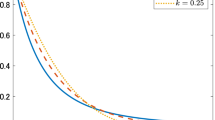Abstract
In this paper estimation of the shape parameter of a Pareto distribution is considered under the a priori assumption that it is bounded below by a known constant. The loss function is scale invariant squared error. A class of minimax estimators is presented when the scale parameter of the distribution is known. In consequence, it has been shown that the generalized Bayes estimator with respect to the uniform prior on the truncated parameter space dominates the minimum risk equivariant estimator. By making use of a sequence of proper priors, we also show that this estimator is admissible for estimating the lower bounded shape parameter. A class of truncated linear estimators is studied as well. Some complete class results and a class of minimax estimators for the case of an unknown scale parameter are obtained. The corresponding generalized Bayes estimator is shown to be minimax in this case as well.
Similar content being viewed by others
References
Asrabadi BR (1990) Estimation in Pareto distribution. Metrika 37:199–205
Berger JO (1985) Statistical decision theory and Bayesian analysis, 2nd edn. Springer Science & Business Media, New York
Blyth CR (1951) On minimax statistical procedures and their admissibility. Ann Math Statist 22:22–42
Brewster JF, Zidek JV (1974) Improving on equivariant estimators. Ann Statist 2:21–38
Ghosh JK, Singh R (1970) Estimation of the reciprocal of scale parameter of a gamma distribution. Ann Inst Statist Math 22:51–55
Johnson NL, Kotz S, Balakrishnan N (1994) Continuous univariate distributions. Wiley, New York
Kaluszka M (1986) Admissible and minimax estimators of \(\lambda ^r\) in the gamma distribution with truncated parameter spaces. Metrika 33:363–375
Katz MW (1961) Admissible and minimax estimates of parameters in truncated spaces. Ann Math Statist 32:136–142
Kubokawa T (1994) A unified approach to improving equivariant estimators. Ann Statist 22:290–299
Kubokawa T (2004) Minimaxity in estimation of restricted parameters. J Jpn Statist Soc 34:229–253
Kubokawa T (2005) Estimation of bounded location and scale parameters. J Jpn Statist Soc 35:221–249
Rytgaard M (1990) Estimation in the Pareto distribution. Astin Bull 20:201–216
Saksena SK, Johnson AM (1984) Best unbised estimators for the parameters of a two-parameter Pareto distribution. Metrika 31:77–83
Scollnik DPM (2013) Comments on two papers concerning estimation of the parameters of the Pareto distribution in the prescence of outliers. Stat Methodol 13:1–11
Sharma D (1977) Estimation of the reciprocal of the scale parameter in a shifted exponential distribution. Sankhya 39:203–205
Singh DC, Prakash G, Singh P (2007) Shrinkage testimators for the shape parameter of Pareto distribution using linex loss function. Commun Statist Theor Meth 36:741–753
Singh R (1972) Admissibe estimators of \(\lambda ^r\) in gamma distribution with quadratic loss. Trabajos De Estadistica 23:129–134
Stein C (1964) Inadmissibility of the usual estimator for the variance of a normal distribution with unknown mean. Ann Inst Statist Math 16:155–160
Tripathi YM, Kumar S, Petropoulos C (2014) Improved estimators for parameters of a Pareto distribution with a restricted scale. Stat Methodol 18:1–13
van Eeden C (1995) Minimax estimation of a lower-bounded scale parameter of a gamma distribution for scale-invariant squared-error loss. Cand J Statist 23:245–256
van Eeden C (2006) Restricted parameter space estimation problems: admissibility and minimaxity properties, lecture notes in statistics. Springer, New York
Acknowledgments
The authors are thankful to the referees for their valuable suggestions which have significantly improved the content and the presentation of the paper. Particularly comments from an anonymous referee is highly appreciated. They also thank the Editor for encouraging comments. The research work of Yogesh Mani Tripathi is partially supported by a grant \(SR/S4/MS: 785/12\) from the Department of Science and Technology, India, and the author gratefully acknowledges this financial support.
Author information
Authors and Affiliations
Corresponding author
Appendix
Appendix
Proof of Theorem 2.1
The risk difference the estimators \(\delta _{g}(T)\) and \(\delta _{BS}(T)\) is given by
Since \(g(y)\) is nondecreasing, \(\varDelta (\tau )\) will be nonpositive if
In the last equality we use the transformation \(\tau \,t = u\) to obtain
where \(\tau ^{*} = \tau \, y, ~ \tau _0^{*} = \tau _{0}\, y\). The expectation is taken with respect to the density \(f^{*}(u) = u^{n-3}\, e^{- u}\) truncated on \((\tau ^{*}, \infty )\). Observe that \(f^{*}(u)\) has increasing MLR in \(\tau \). Thus we have
So
This completes the proof of the theorem.
Consider the following functions
Lemma 6.1
\(\frac{g_{m}(t)}{\tau _0\, G_{m}(t)} \le 1\) for all \(m\ge 1\).
Proof
For \(m\ge 1\)
\(G_{m}(t) = \int _{t}^{\infty }\, u^{m-1}\, e^{-\tau _0\, u}\, du \ge t^{m-1}\, \int _{t}^{\infty }\,e^{-\tau _0\, u}\, du = \frac{1}{\tau _0}\, t^{m-1}\, e^{-\tau _0\, t} = \frac{g_{m}(t)}{\tau _0}\).
As a consequence of the above lemma we have the following result.
Lemma 6.2
and if \(p=l\) then
where the expectation is taken with respect to the joint distribution of \(X\) and \(\tau \).
Proof
Lemma 6.3
\(E\Big (\frac{U(T)}{T}\Big ) = -\frac{1}{n-1} E(U'(T)) + \frac{\tau }{n-1}\, E(U(T))\), \(T \sim G(n, \tau )\)
Proof
Lemma 6.4
\(\lim _{\xi \rightarrow \infty } ({r_{\xi }}(\delta _{GB}) - r_{\xi }(\delta _{\xi }) )= 0.\)
Proof
In a similar way,
Considering that,
-
1.
\(\displaystyle n_{\xi } = n - \frac{1}{\xi } \rightarrow _{\xi \rightarrow + \infty } n\)
-
2.
\(\displaystyle g_{n_{\xi }-2}(t) = e^{- \tau _0 t} t^{n_{\xi } - 2 - 1} \rightarrow _{\xi \rightarrow + \infty } e^{- \tau _0 t} t^{n - 2 - 1} = g_{n-2}(t)\)
-
3.
\(\displaystyle G_{n_{\xi }-2}(t) \!=\! \int _t^{+ \infty } \, e^{- \tau _0 u} u^{n_{\xi } - 2 - 1} du \rightarrow _{\xi \rightarrow + \infty } \int _t^{+ \infty } \, e^{- \tau _0 u} u^{n - 2 - 1} du = G_{n-2}(t)\).
It is obvious that, \(\lim _{\xi \rightarrow \infty } ({r_{\xi }}(\delta _{GB}) - r_{\xi }(\delta _{\xi }) ) = 0.\)
Rights and permissions
About this article
Cite this article
Tripathi, Y.M., Kumar, S. & Petropoulos, C. Estimating the shape parameter of a Pareto distribution under restrictions. Metrika 79, 91–111 (2016). https://doi.org/10.1007/s00184-015-0545-9
Received:
Published:
Issue Date:
DOI: https://doi.org/10.1007/s00184-015-0545-9
Keywords
- Restricted maximum likelihood estimator
- Generalized Bayes estimator
- Integral expression of risk difference
- Scale invariance
- Stein-type estimator



